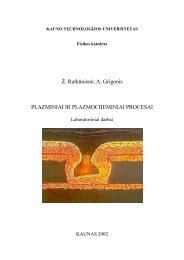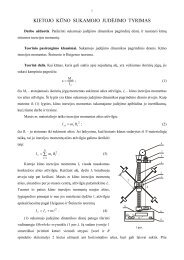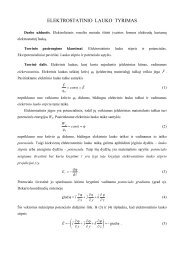PROCEEDINGS OF THE 7 INTERNATIONAL ... - Fizika
PROCEEDINGS OF THE 7 INTERNATIONAL ... - Fizika
PROCEEDINGS OF THE 7 INTERNATIONAL ... - Fizika
You also want an ePaper? Increase the reach of your titles
YUMPU automatically turns print PDFs into web optimized ePapers that Google loves.
V. Poderys et al. / Medical Physics in the Baltic States 7 (2009) 24 - 29<br />
absorption band intensity dynamics: B- in deionized water<br />
(insert shows initial absorption change 0-48 h), D – in saline,<br />
(concentration of quantum dots, c=3,84·10 -7 mol/l).<br />
Quantum dots absorbance is decreased after 24 hours<br />
but later it slowly increases till 192 nd hour. After 192 nd<br />
hour precipitate starts forming and absorbance<br />
intensity decreases.<br />
In case when saline is used instead of deionized water,<br />
one can see similar changes of CdTe quantum dots<br />
photoluminescence properties like described above.<br />
During first stage photoluminescence intensity<br />
increases, and photoluminescence band maximum<br />
position and width at half maximum remains constant,<br />
respectively 548 nm and 53 nm. At this stage<br />
photoluminescence intensity increases to 166 % of<br />
initial value (from 389 a.u. to 648 a.u.) at 144 th hour.<br />
Later photoluminescence intensity starts to decrease<br />
and 274 hours after preparation of solution is close to<br />
zero (40 a.u.). During this stage, when<br />
photoluminescence intensity is decreasing,<br />
photoluminescence band starts to shift<br />
bathochromically (163 th hour) and shifts by 25 nm<br />
from 550 nm to 575 nm (at 244 hour). Width of<br />
photoluminescence band starts to decrease 226 hours<br />
after solution preparation and narrows by 9 nm (from<br />
54 nm to 45 nm at 253 hour). Absorbance band<br />
intensity dependence on time is presented in Fig. 1D.<br />
Quantum dots absorbance in saline remains constant<br />
till 192 nd hour. After 192 nd hour precipitate starts<br />
forming and absorbance intensity decreases (Fig. 1 D<br />
insert). All these changes are very similar to changes<br />
that appear when quantum dots are dissolved in<br />
deionized water. Intensity increase, shift of<br />
photoluminescence band and decrease of band width in<br />
both cases are very similar: intensity increases by<br />
168% (deionized water) and 166% (saline), band shifts<br />
by 26 nm (deionized water) and 25 nm (saline), band<br />
narrows by 8 nm (deionized water) and 9 nm (saline).<br />
Despite all these similarities one difference can also be<br />
observed: phase of photoluminescence growth is<br />
longer in case of quantum dots in saline (144 hours<br />
compared to 88 hours).<br />
These results show that presence of Na + and Cl - ions<br />
doesn’t make big influence on spectral properties of<br />
CdTe quantum dots in aqueous media.<br />
In biological objects quantum dots are exposed to<br />
various ions and biomolecules. In circulatory system<br />
quantum dots stars to interact with serum proteins.<br />
Freshly prepared CdTe quantum dots solution (V=2<br />
ml) was titrated with BSA solution (c=10 -4 mol/l). Fig.<br />
2 shows, that adding BSA to CdTe quantum dots<br />
solution increases their photoluminescence intensity up<br />
to certain concentration of BSA. Saturation is achieved<br />
when concentration of protein is c=10 -5 mol/l. Further<br />
titration leads to photoluminescence decrease (Fig. 2<br />
line A). Change of photoluminescence intensity is<br />
caused by two processes: interaction of quantum dots<br />
with proteins and dilution effect. Graph of reference<br />
solution (titrated with saline) is presented in Fig. 2<br />
(line B). Difference between photoluminescence<br />
26<br />
intensity of solution titrated with BSA and<br />
photoluminescence of solution titrated with saline gives<br />
photoluminescence change caused by interaction between<br />
CdTe quantum dots and BSA (Fig.2 line C). This line<br />
reaches its maximum value at c=1.05·10 -5 mol/l.<br />
Photoluminescence Intensity, a.u.<br />
900<br />
800<br />
700<br />
600<br />
+ n* 20μl saline<br />
+ n* 20μl BSA sollution<br />
Change of PL intensity<br />
0.0 1.0x10 -5<br />
Concentration of BSA, mol/l<br />
2.0x10 -5<br />
300<br />
200<br />
100<br />
Fig. 2 CdTe quantum dots (CdTe c = 4,8 · 10 -7 mol/l, V = 2 ml)<br />
photo photoluminescence intensity:<br />
A – during titration with BSA solution (c = 10 -4 mol/l), B –<br />
titration with saline, C –change of photoluminescence intensity<br />
caused by BSA (dilution effect is eliminated).<br />
For further investigations we chose c = 1.5·10 -5 mol/l<br />
concentration of albumin. We decided to use 1.5 time<br />
bigger concentration, than concentration giving biggest<br />
photoluminescence increase, to ensure that all quantum<br />
dots are interacting with BSA. Photoluminescence<br />
spectral properties and absorption band intensity<br />
dynamics of CdTe quantum dots aqueous solutions with<br />
BSA is presented in Fig. 3. After the addition of protein<br />
photoluminescence of quantum dots suddenly increases<br />
(by 27% and 68% a.u. for saline and deionized water<br />
solutions, respectively). After jump, photoluminescence<br />
intensity further increases for approximately 40 hours<br />
and reaches 157% of initial value for saline and 184 % of<br />
initial value for deionized water solution. Later<br />
photoluminescence intensity starts decreasing, but<br />
decrease of intensity is quite slow and at longer time<br />
scale becomes negligible. This shows that BSA stabilizes<br />
CdTe quantum dots in aqueous media.<br />
Even after two months quantum dots remain in solution<br />
and precipitates don’t appear (Fig.3 D insert).<br />
Photoluminescence of quantum dots solutions with<br />
protein remains more intense than 50% of initial value.<br />
Absence of precipitate and quite intense<br />
photoluminescence of quantum dots solutions shows that<br />
BSA prevents quantum dots from aggregation. AFM<br />
measurements of long kept solutions confirm this idea. In<br />
Fig. 4 D CdTe quantum dots, deposited from saline<br />
solution after precipitate was formed, is presented. Large<br />
layered structures are seen on the surface. Height of these<br />
images is 70nm – 130 nm. Phase image (insert of Fig. 4<br />
D) clearly shows that these large structures are formed<br />
from layers. Height of one layer is approximately equal<br />
to 3.5nm - 4 nm. Diameter of CdTe quantum dots that<br />
A<br />
C<br />
B<br />
0<br />
Change of Photoluminescence Intensity, a.u.








